MRKT19031 Case Study: Consumer Behavior Analysis of Toyota
VerifiedAdded on 2023/06/11
|10
|2086
|324
Case Study
AI Summary
This case study delves into the consumer behavior of potential Toyota customers, analyzing the factors influencing their purchasing decisions. The study employs a compensatory decision rule based on surveys of three respondents, considering aspects such as engine type, safety features, and price. The analysis reveals the impact of age, income, marital status, and education level on consumer preferences. Recommendations are provided for Toyota to tailor their products and marketing strategies to better cater to diverse customer needs and preferences, emphasizing personalized payment options and minimizing family influence on individual decisions. Desklib offers a variety of solved assignments and past papers for students.
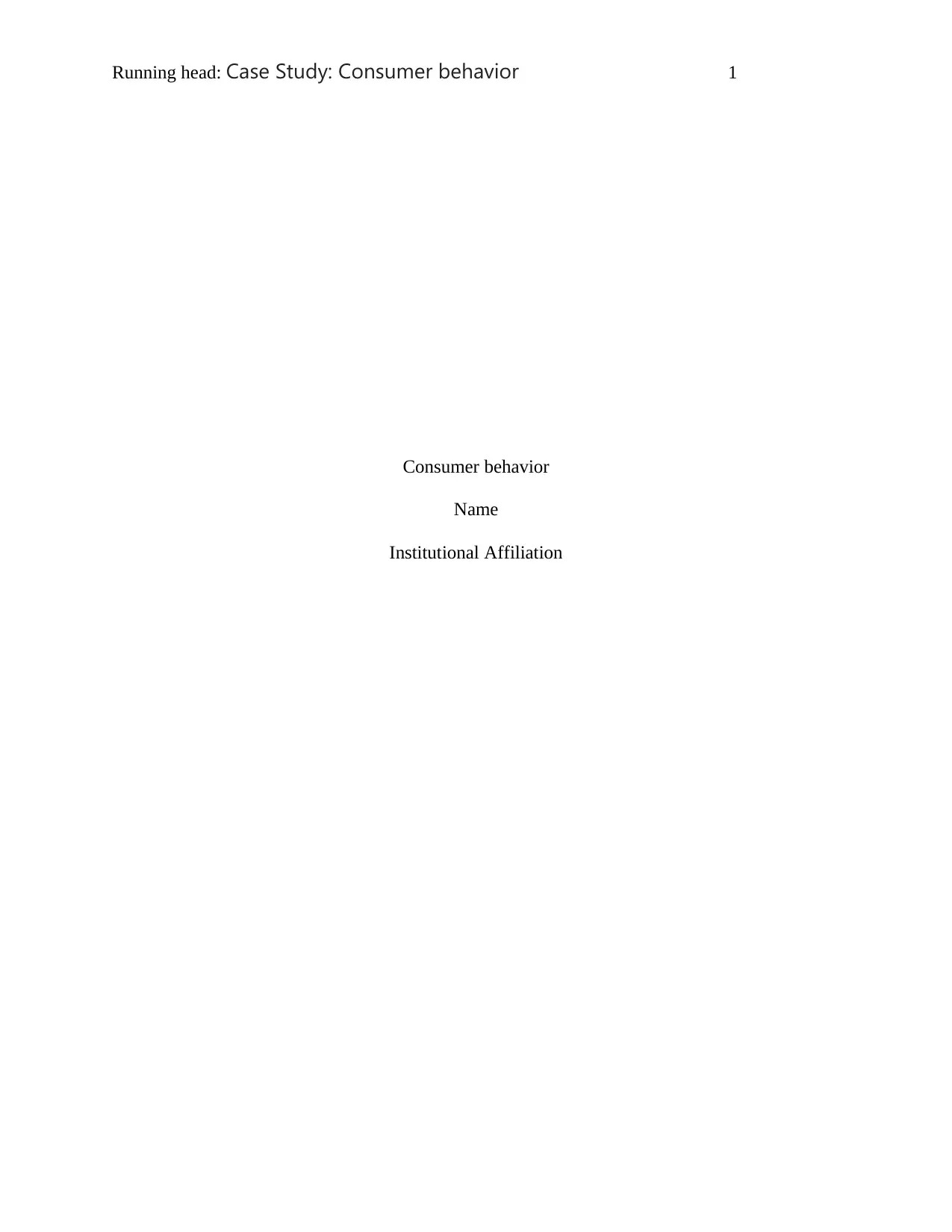
Running head: Case Study: Consumer behavior 1
Consumer behavior
Name
Institutional Affiliation
Consumer behavior
Name
Institutional Affiliation
Paraphrase This Document
Need a fresh take? Get an instant paraphrase of this document with our AI Paraphraser
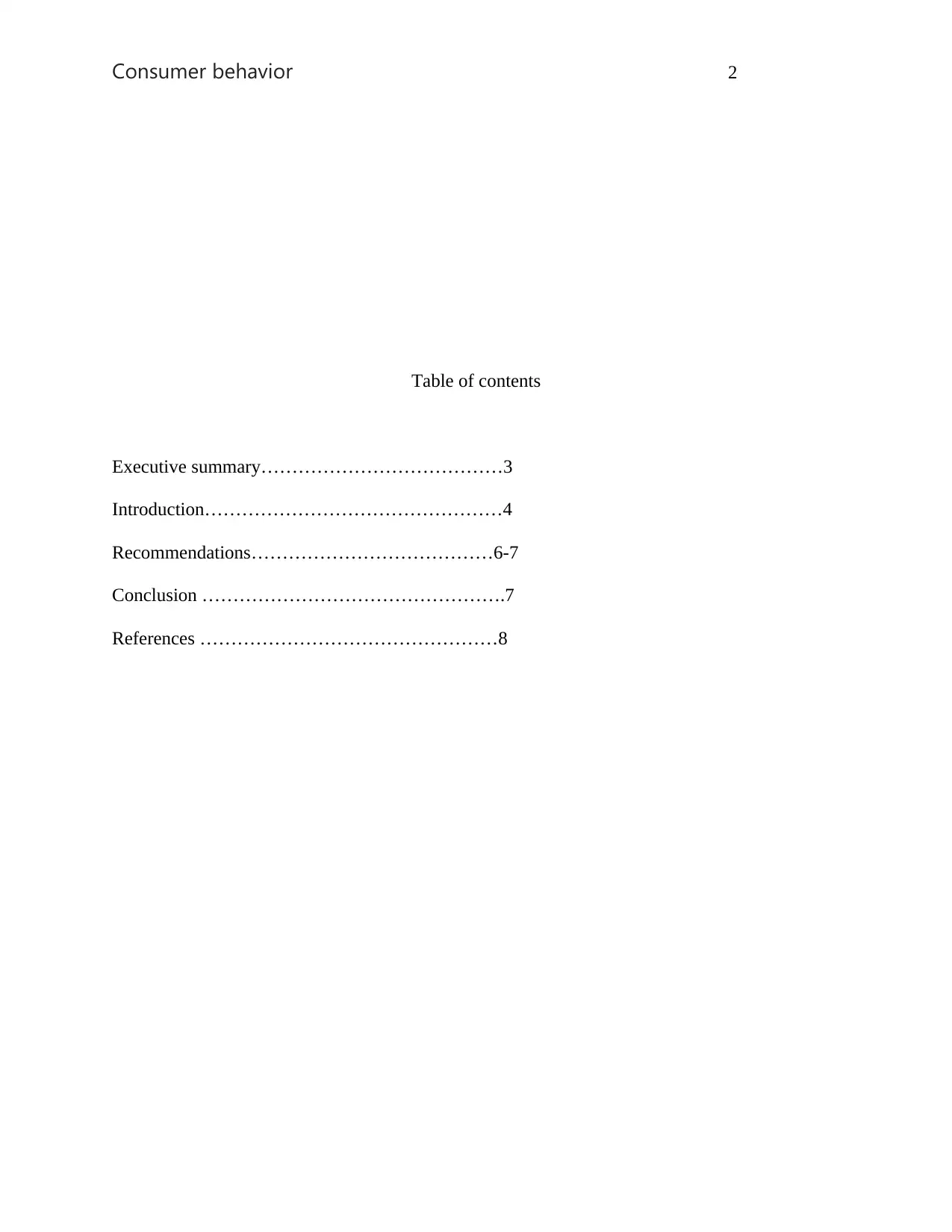
Consumer behavior 2
Table of contents
Executive summary…………………………………3
Introduction…………………………………………4
Recommendations…………………………………6-7
Conclusion ………………………………………….7
References …………………………………………8
Table of contents
Executive summary…………………………………3
Introduction…………………………………………4
Recommendations…………………………………6-7
Conclusion ………………………………………….7
References …………………………………………8
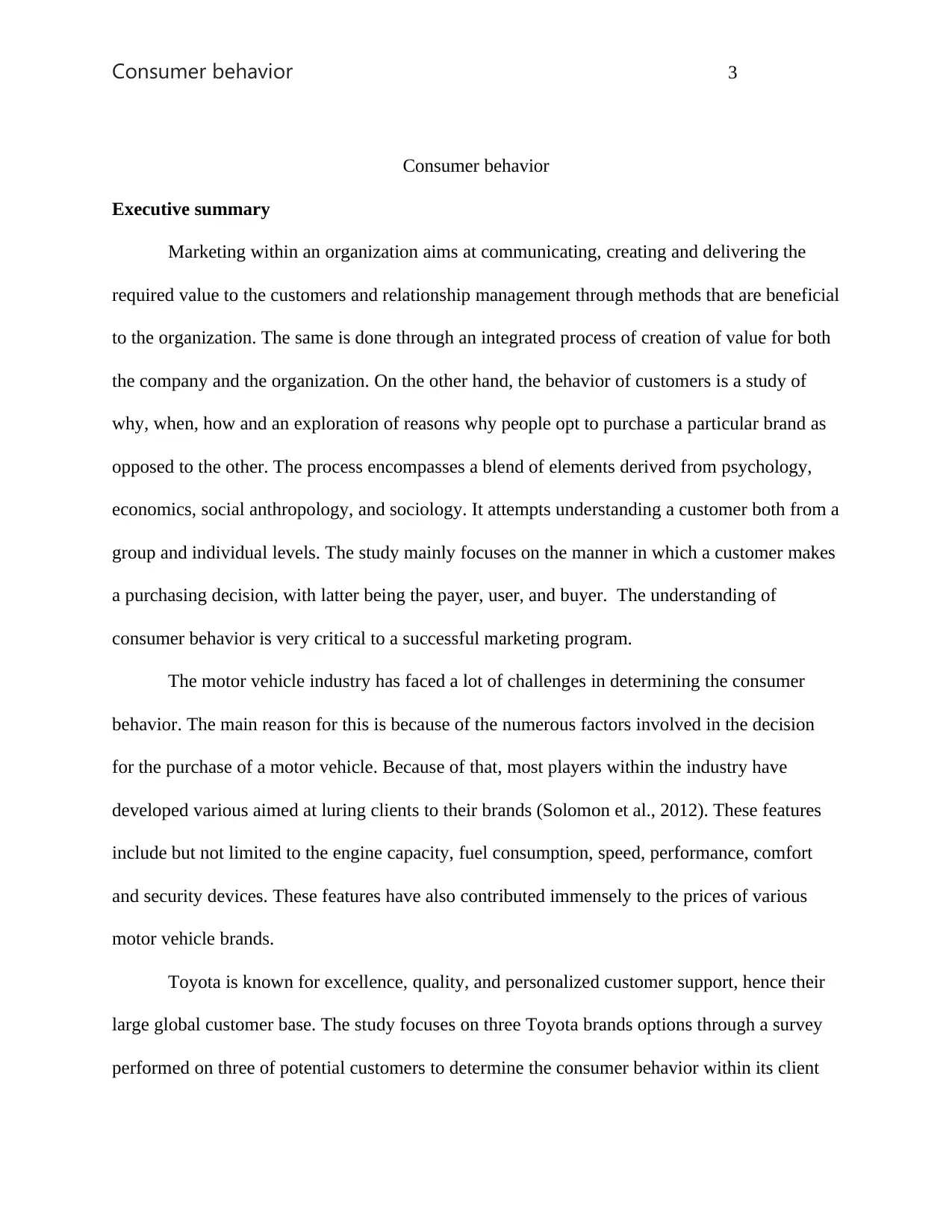
Consumer behavior 3
Consumer behavior
Executive summary
Marketing within an organization aims at communicating, creating and delivering the
required value to the customers and relationship management through methods that are beneficial
to the organization. The same is done through an integrated process of creation of value for both
the company and the organization. On the other hand, the behavior of customers is a study of
why, when, how and an exploration of reasons why people opt to purchase a particular brand as
opposed to the other. The process encompasses a blend of elements derived from psychology,
economics, social anthropology, and sociology. It attempts understanding a customer both from a
group and individual levels. The study mainly focuses on the manner in which a customer makes
a purchasing decision, with latter being the payer, user, and buyer. The understanding of
consumer behavior is very critical to a successful marketing program.
The motor vehicle industry has faced a lot of challenges in determining the consumer
behavior. The main reason for this is because of the numerous factors involved in the decision
for the purchase of a motor vehicle. Because of that, most players within the industry have
developed various aimed at luring clients to their brands (Solomon et al., 2012). These features
include but not limited to the engine capacity, fuel consumption, speed, performance, comfort
and security devices. These features have also contributed immensely to the prices of various
motor vehicle brands.
Toyota is known for excellence, quality, and personalized customer support, hence their
large global customer base. The study focuses on three Toyota brands options through a survey
performed on three of potential customers to determine the consumer behavior within its client
Consumer behavior
Executive summary
Marketing within an organization aims at communicating, creating and delivering the
required value to the customers and relationship management through methods that are beneficial
to the organization. The same is done through an integrated process of creation of value for both
the company and the organization. On the other hand, the behavior of customers is a study of
why, when, how and an exploration of reasons why people opt to purchase a particular brand as
opposed to the other. The process encompasses a blend of elements derived from psychology,
economics, social anthropology, and sociology. It attempts understanding a customer both from a
group and individual levels. The study mainly focuses on the manner in which a customer makes
a purchasing decision, with latter being the payer, user, and buyer. The understanding of
consumer behavior is very critical to a successful marketing program.
The motor vehicle industry has faced a lot of challenges in determining the consumer
behavior. The main reason for this is because of the numerous factors involved in the decision
for the purchase of a motor vehicle. Because of that, most players within the industry have
developed various aimed at luring clients to their brands (Solomon et al., 2012). These features
include but not limited to the engine capacity, fuel consumption, speed, performance, comfort
and security devices. These features have also contributed immensely to the prices of various
motor vehicle brands.
Toyota is known for excellence, quality, and personalized customer support, hence their
large global customer base. The study focuses on three Toyota brands options through a survey
performed on three of potential customers to determine the consumer behavior within its client
⊘ This is a preview!⊘
Do you want full access?
Subscribe today to unlock all pages.

Trusted by 1+ million students worldwide
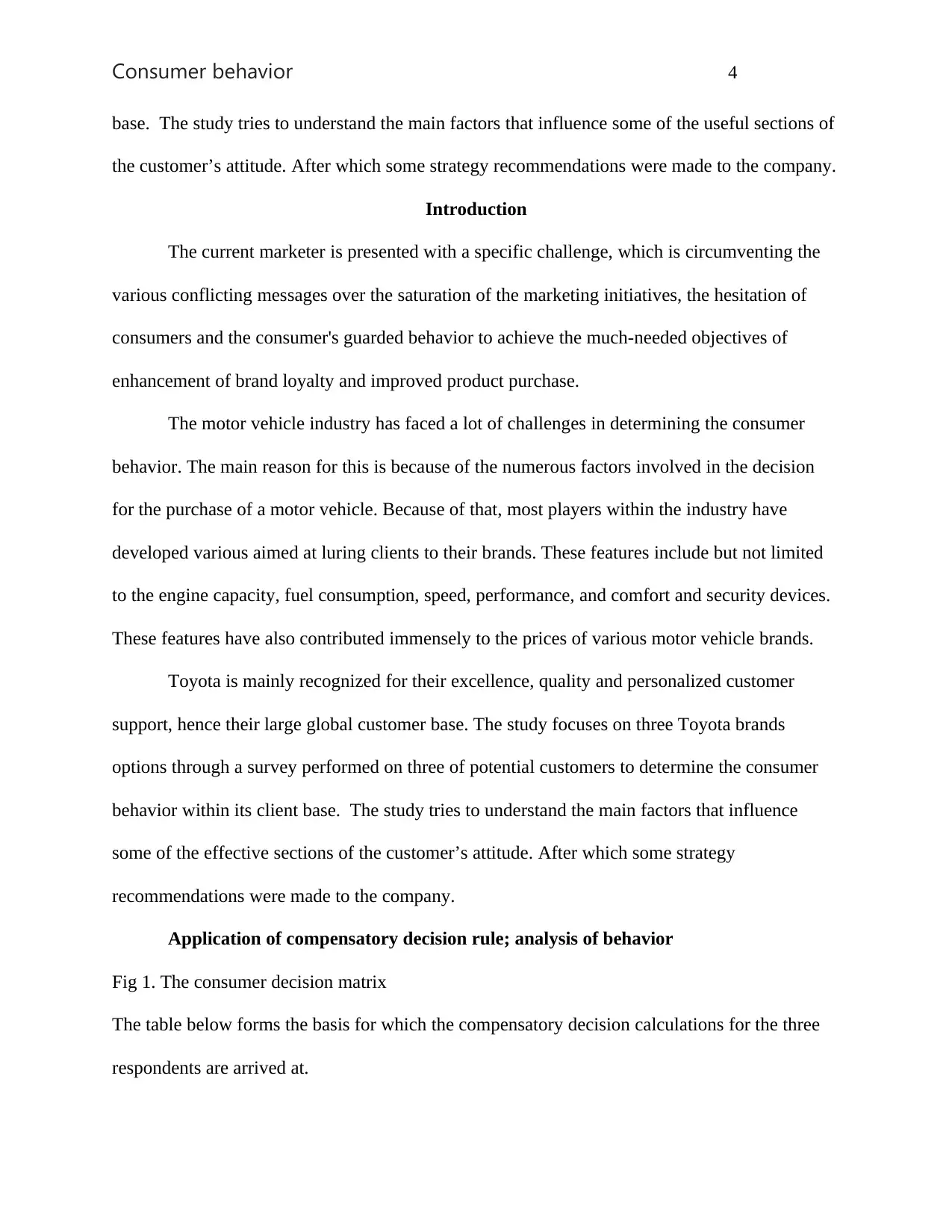
Consumer behavior 4
base. The study tries to understand the main factors that influence some of the useful sections of
the customer’s attitude. After which some strategy recommendations were made to the company.
Introduction
The current marketer is presented with a specific challenge, which is circumventing the
various conflicting messages over the saturation of the marketing initiatives, the hesitation of
consumers and the consumer's guarded behavior to achieve the much-needed objectives of
enhancement of brand loyalty and improved product purchase.
The motor vehicle industry has faced a lot of challenges in determining the consumer
behavior. The main reason for this is because of the numerous factors involved in the decision
for the purchase of a motor vehicle. Because of that, most players within the industry have
developed various aimed at luring clients to their brands. These features include but not limited
to the engine capacity, fuel consumption, speed, performance, and comfort and security devices.
These features have also contributed immensely to the prices of various motor vehicle brands.
Toyota is mainly recognized for their excellence, quality and personalized customer
support, hence their large global customer base. The study focuses on three Toyota brands
options through a survey performed on three of potential customers to determine the consumer
behavior within its client base. The study tries to understand the main factors that influence
some of the effective sections of the customer’s attitude. After which some strategy
recommendations were made to the company.
Application of compensatory decision rule; analysis of behavior
Fig 1. The consumer decision matrix
The table below forms the basis for which the compensatory decision calculations for the three
respondents are arrived at.
base. The study tries to understand the main factors that influence some of the useful sections of
the customer’s attitude. After which some strategy recommendations were made to the company.
Introduction
The current marketer is presented with a specific challenge, which is circumventing the
various conflicting messages over the saturation of the marketing initiatives, the hesitation of
consumers and the consumer's guarded behavior to achieve the much-needed objectives of
enhancement of brand loyalty and improved product purchase.
The motor vehicle industry has faced a lot of challenges in determining the consumer
behavior. The main reason for this is because of the numerous factors involved in the decision
for the purchase of a motor vehicle. Because of that, most players within the industry have
developed various aimed at luring clients to their brands. These features include but not limited
to the engine capacity, fuel consumption, speed, performance, and comfort and security devices.
These features have also contributed immensely to the prices of various motor vehicle brands.
Toyota is mainly recognized for their excellence, quality and personalized customer
support, hence their large global customer base. The study focuses on three Toyota brands
options through a survey performed on three of potential customers to determine the consumer
behavior within its client base. The study tries to understand the main factors that influence
some of the effective sections of the customer’s attitude. After which some strategy
recommendations were made to the company.
Application of compensatory decision rule; analysis of behavior
Fig 1. The consumer decision matrix
The table below forms the basis for which the compensatory decision calculations for the three
respondents are arrived at.
Paraphrase This Document
Need a fresh take? Get an instant paraphrase of this document with our AI Paraphraser

Consumer behavior 5
Respo
ndent
1
Respo
ndent
2
Respo
ndent
3
Respo
ndent
1
Respo
ndent
2
Respo
ndent
3
Respo
ndent
1
Respo
ndent
2
Respo
ndent
3
Respo
ndent
1
Respo
ndent
2
Respo
ndent
3
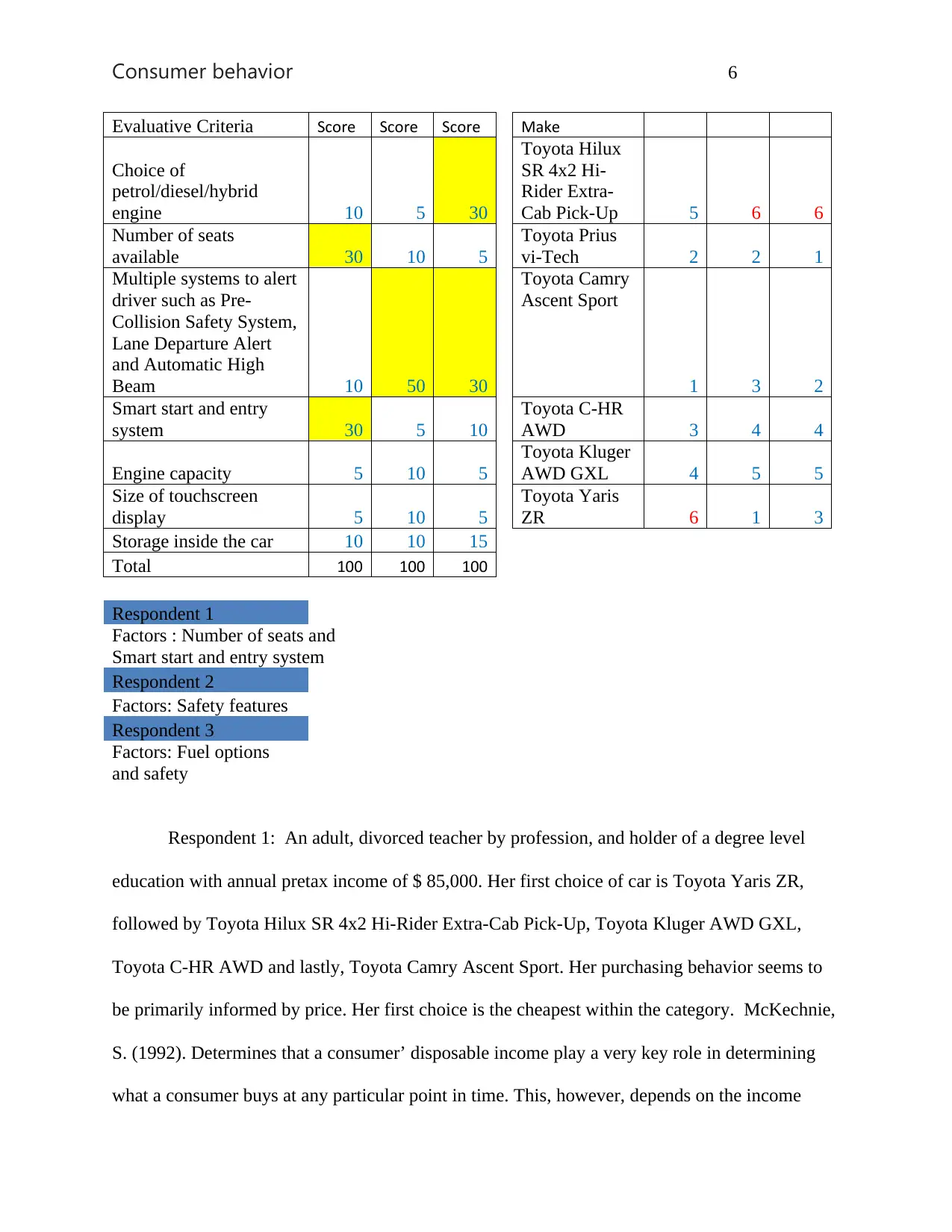
Consumer behavior 6
Evaluative Criteria Score Score Score Make
Choice of
petrol/diesel/hybrid
engine 10 5 30
Toyota Hilux
SR 4x2 Hi-
Rider Extra-
Cab Pick-Up 5 6 6
Number of seats
available 30 10 5
Toyota Prius
vi-Tech 2 2 1
Multiple systems to alert
driver such as Pre-
Collision Safety System,
Lane Departure Alert
and Automatic High
Beam 10 50 30
Toyota Camry
Ascent Sport
1 3 2
Smart start and entry
system 30 5 10
Toyota C-HR
AWD 3 4 4
Engine capacity 5 10 5
Toyota Kluger
AWD GXL 4 5 5
Size of touchscreen
display 5 10 5
Toyota Yaris
ZR 6 1 3
Storage inside the car 10 10 15
Total 100 100 100
Respondent 1
Factors : Number of seats and
Smart start and entry system
Respondent 2
Factors: Safety features
Respondent 3
Factors: Fuel options
and safety
Respondent 1: An adult, divorced teacher by profession, and holder of a degree level
education with annual pretax income of $ 85,000. Her first choice of car is Toyota Yaris ZR,
followed by Toyota Hilux SR 4x2 Hi-Rider Extra-Cab Pick-Up, Toyota Kluger AWD GXL,
Toyota C-HR AWD and lastly, Toyota Camry Ascent Sport. Her purchasing behavior seems to
be primarily informed by price. Her first choice is the cheapest within the category. McKechnie,
S. (1992). Determines that a consumer’ disposable income play a very key role in determining
what a consumer buys at any particular point in time. This, however, depends on the income
Evaluative Criteria Score Score Score Make
Choice of
petrol/diesel/hybrid
engine 10 5 30
Toyota Hilux
SR 4x2 Hi-
Rider Extra-
Cab Pick-Up 5 6 6
Number of seats
available 30 10 5
Toyota Prius
vi-Tech 2 2 1
Multiple systems to alert
driver such as Pre-
Collision Safety System,
Lane Departure Alert
and Automatic High
Beam 10 50 30
Toyota Camry
Ascent Sport
1 3 2
Smart start and entry
system 30 5 10
Toyota C-HR
AWD 3 4 4
Engine capacity 5 10 5
Toyota Kluger
AWD GXL 4 5 5
Size of touchscreen
display 5 10 5
Toyota Yaris
ZR 6 1 3
Storage inside the car 10 10 15
Total 100 100 100
Respondent 1
Factors : Number of seats and
Smart start and entry system
Respondent 2
Factors: Safety features
Respondent 3
Factors: Fuel options
and safety
Respondent 1: An adult, divorced teacher by profession, and holder of a degree level
education with annual pretax income of $ 85,000. Her first choice of car is Toyota Yaris ZR,
followed by Toyota Hilux SR 4x2 Hi-Rider Extra-Cab Pick-Up, Toyota Kluger AWD GXL,
Toyota C-HR AWD and lastly, Toyota Camry Ascent Sport. Her purchasing behavior seems to
be primarily informed by price. Her first choice is the cheapest within the category. McKechnie,
S. (1992). Determines that a consumer’ disposable income play a very key role in determining
what a consumer buys at any particular point in time. This, however, depends on the income
⊘ This is a preview!⊘
Do you want full access?
Subscribe today to unlock all pages.

Trusted by 1+ million students worldwide
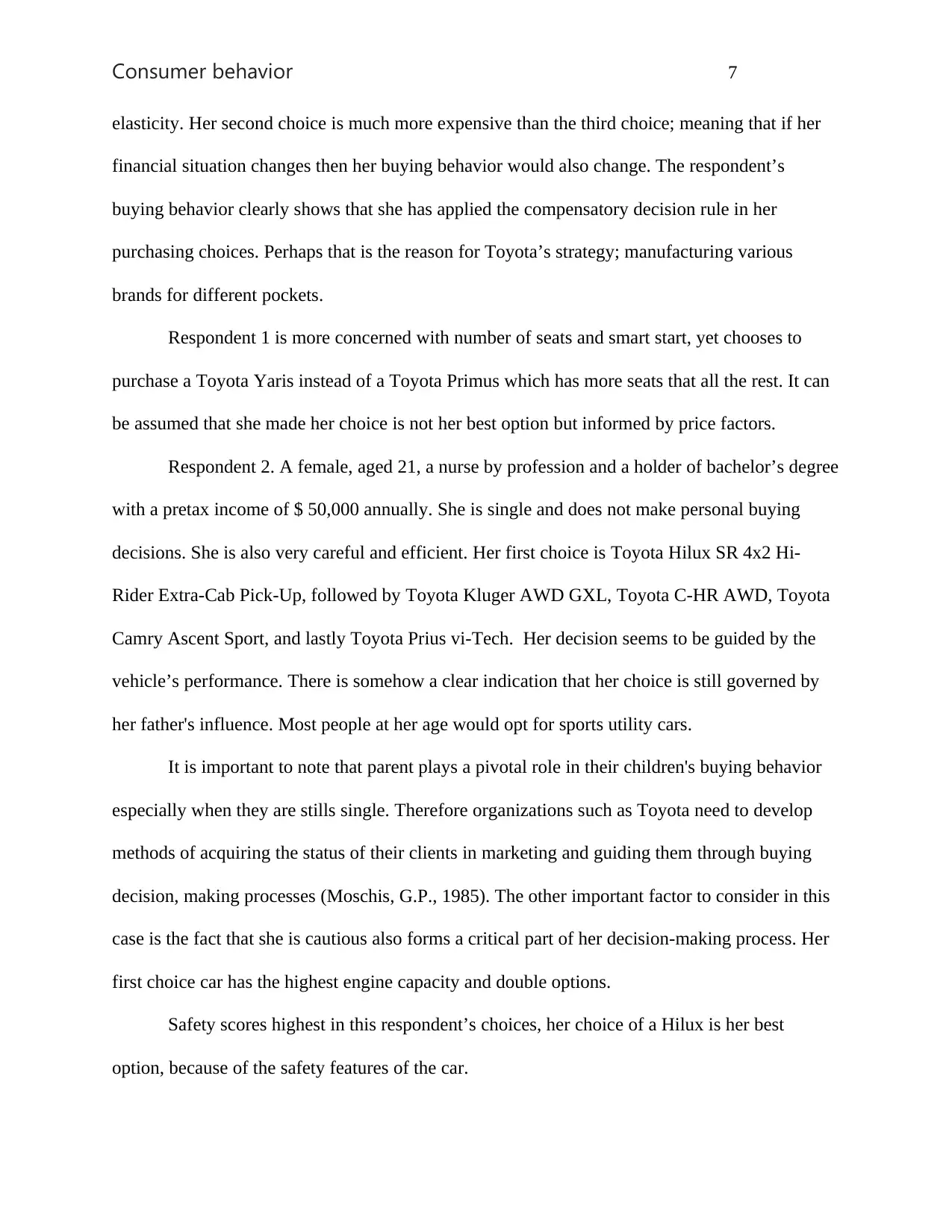
Consumer behavior 7
elasticity. Her second choice is much more expensive than the third choice; meaning that if her
financial situation changes then her buying behavior would also change. The respondent’s
buying behavior clearly shows that she has applied the compensatory decision rule in her
purchasing choices. Perhaps that is the reason for Toyota’s strategy; manufacturing various
brands for different pockets.
Respondent 1 is more concerned with number of seats and smart start, yet chooses to
purchase a Toyota Yaris instead of a Toyota Primus which has more seats that all the rest. It can
be assumed that she made her choice is not her best option but informed by price factors.
Respondent 2. A female, aged 21, a nurse by profession and a holder of bachelor’s degree
with a pretax income of $ 50,000 annually. She is single and does not make personal buying
decisions. She is also very careful and efficient. Her first choice is Toyota Hilux SR 4x2 Hi-
Rider Extra-Cab Pick-Up, followed by Toyota Kluger AWD GXL, Toyota C-HR AWD, Toyota
Camry Ascent Sport, and lastly Toyota Prius vi-Tech. Her decision seems to be guided by the
vehicle’s performance. There is somehow a clear indication that her choice is still governed by
her father's influence. Most people at her age would opt for sports utility cars.
It is important to note that parent plays a pivotal role in their children's buying behavior
especially when they are stills single. Therefore organizations such as Toyota need to develop
methods of acquiring the status of their clients in marketing and guiding them through buying
decision, making processes (Moschis, G.P., 1985). The other important factor to consider in this
case is the fact that she is cautious also forms a critical part of her decision-making process. Her
first choice car has the highest engine capacity and double options.
Safety scores highest in this respondent’s choices, her choice of a Hilux is her best
option, because of the safety features of the car.
elasticity. Her second choice is much more expensive than the third choice; meaning that if her
financial situation changes then her buying behavior would also change. The respondent’s
buying behavior clearly shows that she has applied the compensatory decision rule in her
purchasing choices. Perhaps that is the reason for Toyota’s strategy; manufacturing various
brands for different pockets.
Respondent 1 is more concerned with number of seats and smart start, yet chooses to
purchase a Toyota Yaris instead of a Toyota Primus which has more seats that all the rest. It can
be assumed that she made her choice is not her best option but informed by price factors.
Respondent 2. A female, aged 21, a nurse by profession and a holder of bachelor’s degree
with a pretax income of $ 50,000 annually. She is single and does not make personal buying
decisions. She is also very careful and efficient. Her first choice is Toyota Hilux SR 4x2 Hi-
Rider Extra-Cab Pick-Up, followed by Toyota Kluger AWD GXL, Toyota C-HR AWD, Toyota
Camry Ascent Sport, and lastly Toyota Prius vi-Tech. Her decision seems to be guided by the
vehicle’s performance. There is somehow a clear indication that her choice is still governed by
her father's influence. Most people at her age would opt for sports utility cars.
It is important to note that parent plays a pivotal role in their children's buying behavior
especially when they are stills single. Therefore organizations such as Toyota need to develop
methods of acquiring the status of their clients in marketing and guiding them through buying
decision, making processes (Moschis, G.P., 1985). The other important factor to consider in this
case is the fact that she is cautious also forms a critical part of her decision-making process. Her
first choice car has the highest engine capacity and double options.
Safety scores highest in this respondent’s choices, her choice of a Hilux is her best
option, because of the safety features of the car.
Paraphrase This Document
Need a fresh take? Get an instant paraphrase of this document with our AI Paraphraser
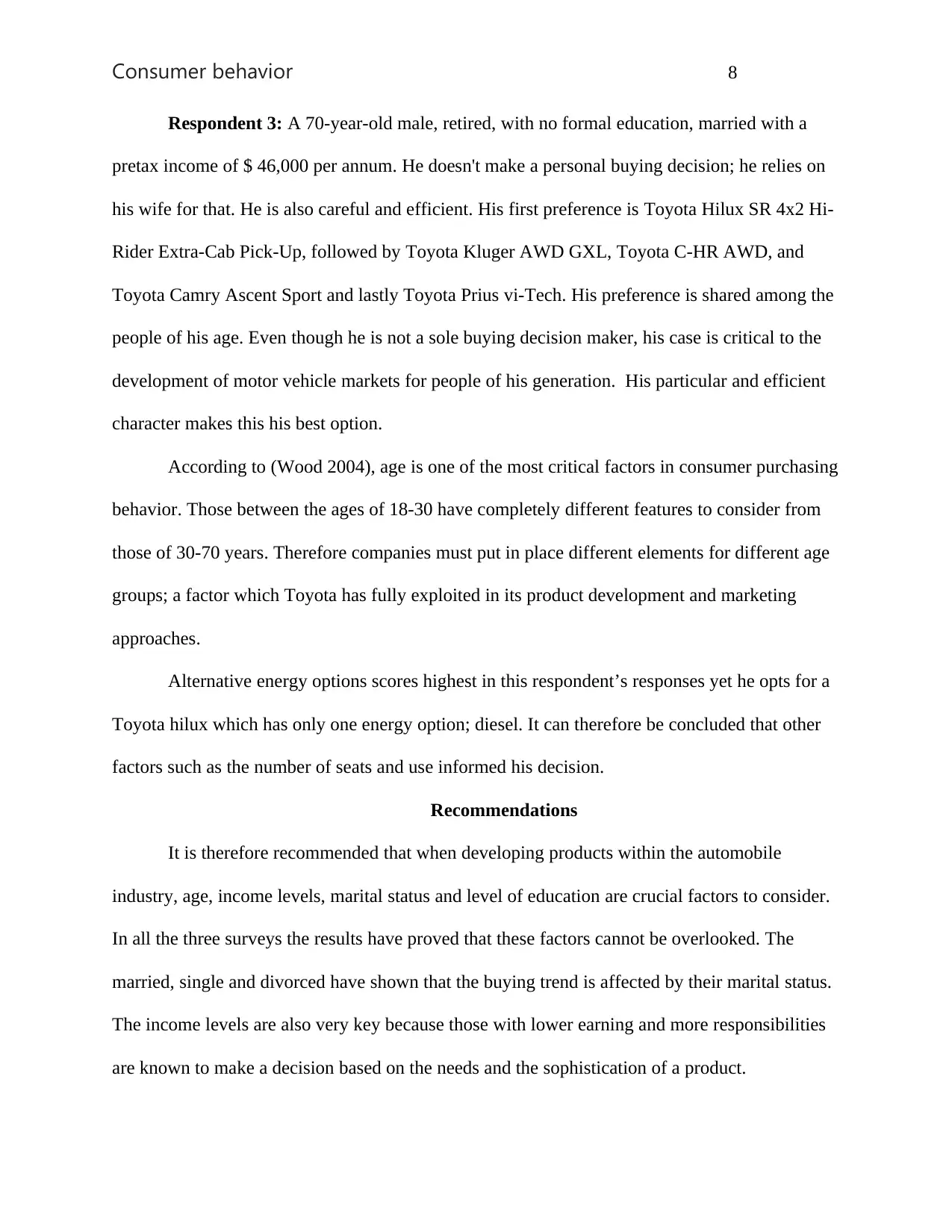
Consumer behavior 8
Respondent 3: A 70-year-old male, retired, with no formal education, married with a
pretax income of $ 46,000 per annum. He doesn't make a personal buying decision; he relies on
his wife for that. He is also careful and efficient. His first preference is Toyota Hilux SR 4x2 Hi-
Rider Extra-Cab Pick-Up, followed by Toyota Kluger AWD GXL, Toyota C-HR AWD, and
Toyota Camry Ascent Sport and lastly Toyota Prius vi-Tech. His preference is shared among the
people of his age. Even though he is not a sole buying decision maker, his case is critical to the
development of motor vehicle markets for people of his generation. His particular and efficient
character makes this his best option.
According to (Wood 2004), age is one of the most critical factors in consumer purchasing
behavior. Those between the ages of 18-30 have completely different features to consider from
those of 30-70 years. Therefore companies must put in place different elements for different age
groups; a factor which Toyota has fully exploited in its product development and marketing
approaches.
Alternative energy options scores highest in this respondent’s responses yet he opts for a
Toyota hilux which has only one energy option; diesel. It can therefore be concluded that other
factors such as the number of seats and use informed his decision.
Recommendations
It is therefore recommended that when developing products within the automobile
industry, age, income levels, marital status and level of education are crucial factors to consider.
In all the three surveys the results have proved that these factors cannot be overlooked. The
married, single and divorced have shown that the buying trend is affected by their marital status.
The income levels are also very key because those with lower earning and more responsibilities
are known to make a decision based on the needs and the sophistication of a product.
Respondent 3: A 70-year-old male, retired, with no formal education, married with a
pretax income of $ 46,000 per annum. He doesn't make a personal buying decision; he relies on
his wife for that. He is also careful and efficient. His first preference is Toyota Hilux SR 4x2 Hi-
Rider Extra-Cab Pick-Up, followed by Toyota Kluger AWD GXL, Toyota C-HR AWD, and
Toyota Camry Ascent Sport and lastly Toyota Prius vi-Tech. His preference is shared among the
people of his age. Even though he is not a sole buying decision maker, his case is critical to the
development of motor vehicle markets for people of his generation. His particular and efficient
character makes this his best option.
According to (Wood 2004), age is one of the most critical factors in consumer purchasing
behavior. Those between the ages of 18-30 have completely different features to consider from
those of 30-70 years. Therefore companies must put in place different elements for different age
groups; a factor which Toyota has fully exploited in its product development and marketing
approaches.
Alternative energy options scores highest in this respondent’s responses yet he opts for a
Toyota hilux which has only one energy option; diesel. It can therefore be concluded that other
factors such as the number of seats and use informed his decision.
Recommendations
It is therefore recommended that when developing products within the automobile
industry, age, income levels, marital status and level of education are crucial factors to consider.
In all the three surveys the results have proved that these factors cannot be overlooked. The
married, single and divorced have shown that the buying trend is affected by their marital status.
The income levels are also very key because those with lower earning and more responsibilities
are known to make a decision based on the needs and the sophistication of a product.
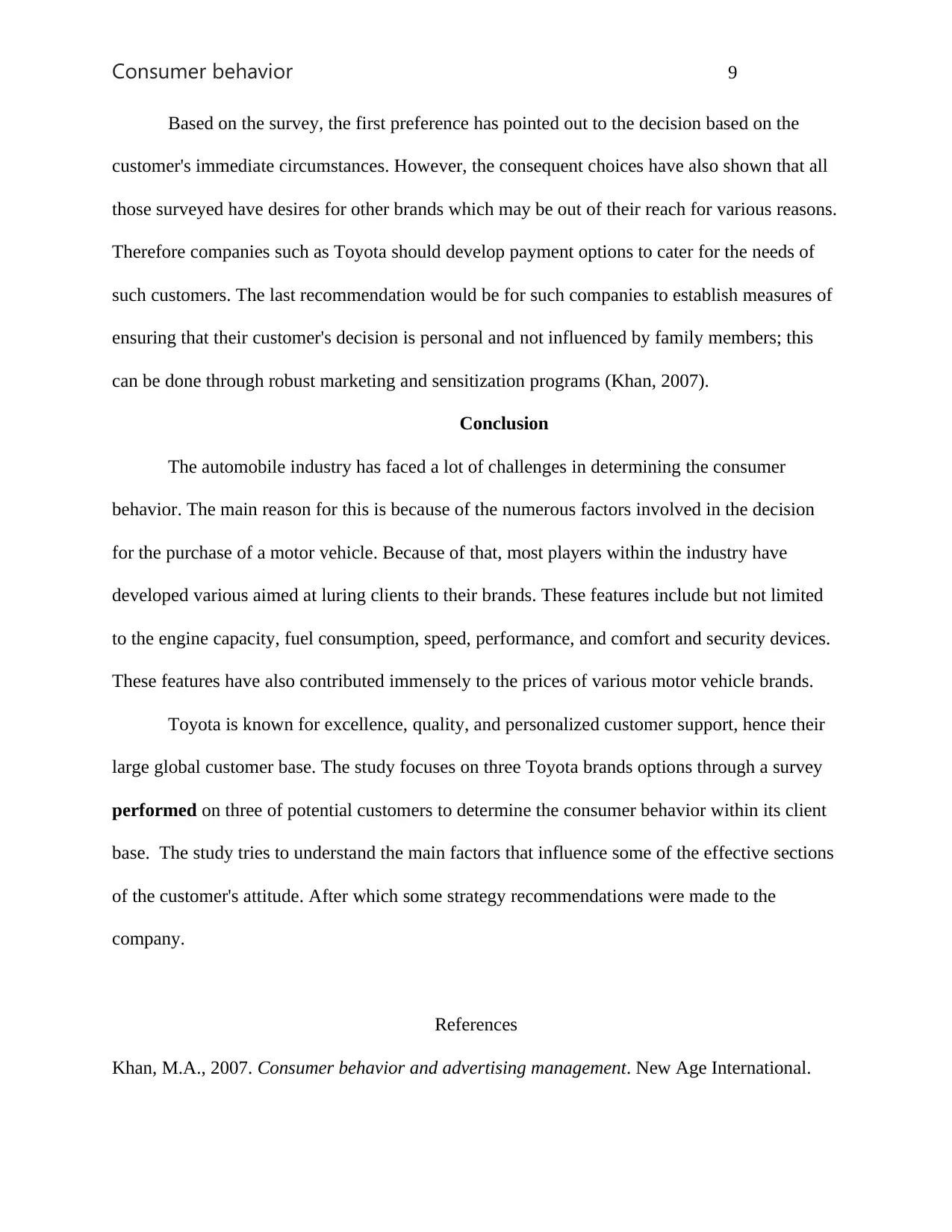
Consumer behavior 9
Based on the survey, the first preference has pointed out to the decision based on the
customer's immediate circumstances. However, the consequent choices have also shown that all
those surveyed have desires for other brands which may be out of their reach for various reasons.
Therefore companies such as Toyota should develop payment options to cater for the needs of
such customers. The last recommendation would be for such companies to establish measures of
ensuring that their customer's decision is personal and not influenced by family members; this
can be done through robust marketing and sensitization programs (Khan, 2007).
Conclusion
The automobile industry has faced a lot of challenges in determining the consumer
behavior. The main reason for this is because of the numerous factors involved in the decision
for the purchase of a motor vehicle. Because of that, most players within the industry have
developed various aimed at luring clients to their brands. These features include but not limited
to the engine capacity, fuel consumption, speed, performance, and comfort and security devices.
These features have also contributed immensely to the prices of various motor vehicle brands.
Toyota is known for excellence, quality, and personalized customer support, hence their
large global customer base. The study focuses on three Toyota brands options through a survey
performed on three of potential customers to determine the consumer behavior within its client
base. The study tries to understand the main factors that influence some of the effective sections
of the customer's attitude. After which some strategy recommendations were made to the
company.
References
Khan, M.A., 2007. Consumer behavior and advertising management. New Age International.
Based on the survey, the first preference has pointed out to the decision based on the
customer's immediate circumstances. However, the consequent choices have also shown that all
those surveyed have desires for other brands which may be out of their reach for various reasons.
Therefore companies such as Toyota should develop payment options to cater for the needs of
such customers. The last recommendation would be for such companies to establish measures of
ensuring that their customer's decision is personal and not influenced by family members; this
can be done through robust marketing and sensitization programs (Khan, 2007).
Conclusion
The automobile industry has faced a lot of challenges in determining the consumer
behavior. The main reason for this is because of the numerous factors involved in the decision
for the purchase of a motor vehicle. Because of that, most players within the industry have
developed various aimed at luring clients to their brands. These features include but not limited
to the engine capacity, fuel consumption, speed, performance, and comfort and security devices.
These features have also contributed immensely to the prices of various motor vehicle brands.
Toyota is known for excellence, quality, and personalized customer support, hence their
large global customer base. The study focuses on three Toyota brands options through a survey
performed on three of potential customers to determine the consumer behavior within its client
base. The study tries to understand the main factors that influence some of the effective sections
of the customer's attitude. After which some strategy recommendations were made to the
company.
References
Khan, M.A., 2007. Consumer behavior and advertising management. New Age International.
⊘ This is a preview!⊘
Do you want full access?
Subscribe today to unlock all pages.

Trusted by 1+ million students worldwide
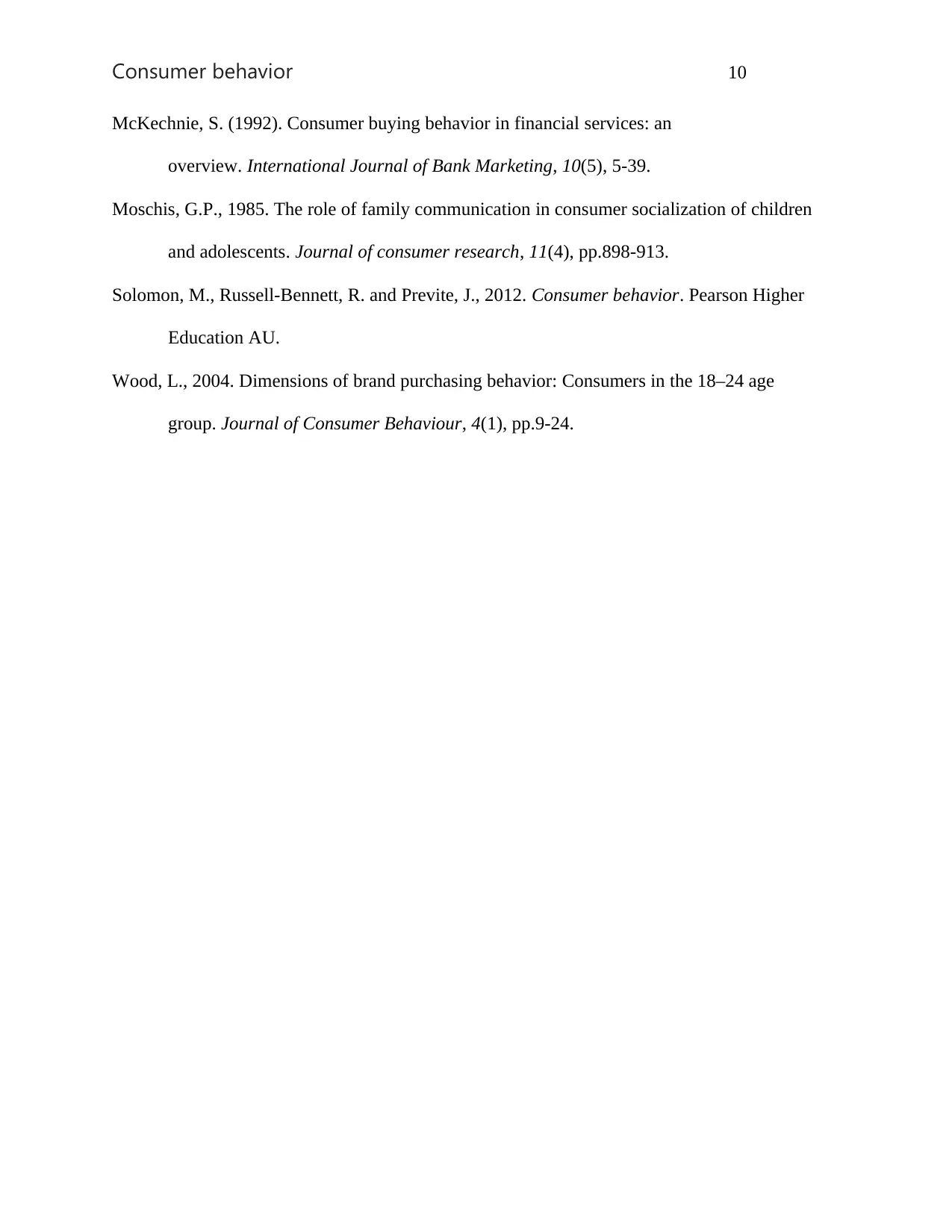
Consumer behavior 10
McKechnie, S. (1992). Consumer buying behavior in financial services: an
overview. International Journal of Bank Marketing, 10(5), 5-39.
Moschis, G.P., 1985. The role of family communication in consumer socialization of children
and adolescents. Journal of consumer research, 11(4), pp.898-913.
Solomon, M., Russell-Bennett, R. and Previte, J., 2012. Consumer behavior. Pearson Higher
Education AU.
Wood, L., 2004. Dimensions of brand purchasing behavior: Consumers in the 18–24 age
group. Journal of Consumer Behaviour, 4(1), pp.9-24.
McKechnie, S. (1992). Consumer buying behavior in financial services: an
overview. International Journal of Bank Marketing, 10(5), 5-39.
Moschis, G.P., 1985. The role of family communication in consumer socialization of children
and adolescents. Journal of consumer research, 11(4), pp.898-913.
Solomon, M., Russell-Bennett, R. and Previte, J., 2012. Consumer behavior. Pearson Higher
Education AU.
Wood, L., 2004. Dimensions of brand purchasing behavior: Consumers in the 18–24 age
group. Journal of Consumer Behaviour, 4(1), pp.9-24.
1 out of 10
Related Documents
Your All-in-One AI-Powered Toolkit for Academic Success.
+13062052269
info@desklib.com
Available 24*7 on WhatsApp / Email
![[object Object]](/_next/static/media/star-bottom.7253800d.svg)
Unlock your academic potential
Copyright © 2020–2025 A2Z Services. All Rights Reserved. Developed and managed by ZUCOL.





